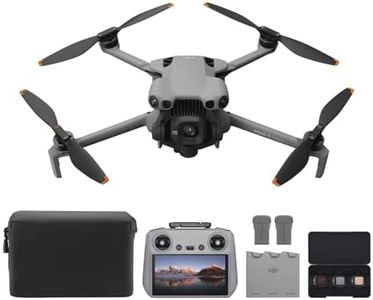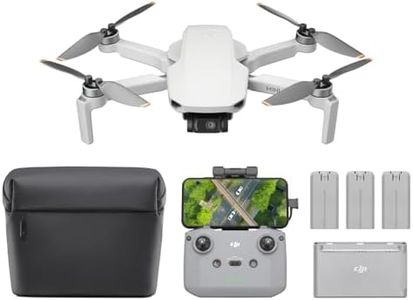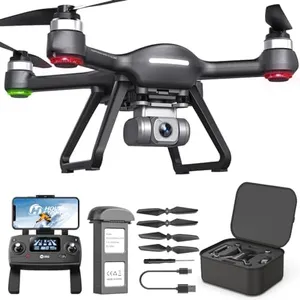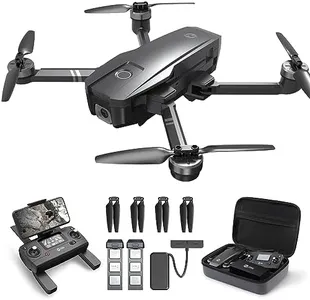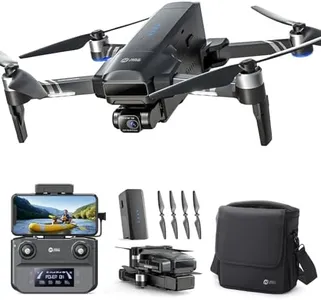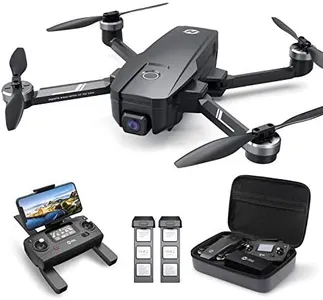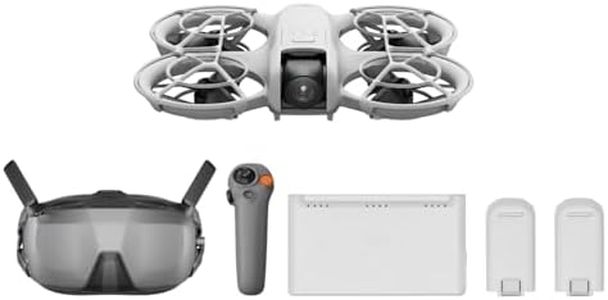10 Best Dji Drones 2025 in the United States
Our technology thoroughly searches through the online shopping world, reviewing hundreds of sites. We then process and analyze this information, updating in real-time to bring you the latest top-rated products. This way, you always get the best and most current options available.

Our Top Picks
Winner
DJI Mavic 4 Pro Fly More Combo with DJI RC 2, Flagship Tri-Camera Drone with 100MP 4/3 CMOS Hasselblad Camera, 30km/18.6mi Video Transmission, 51-Min Max Flight Time, Charging Hub, and More
Most important from
172 reviews
The DJI Mavic 4 Pro Fly More Combo is a high-end drone designed for serious hobbyists and professional aerial photographers. Its standout feature is the impressive 100MP Hasselblad camera with a 4/3 CMOS sensor, delivering ultra-clear photos and 6K/60fps HDR video, making it ideal for capturing detailed and cinematic footage. The addition of dual telephoto cameras provides versatility for zoomed-in shots without losing quality. The drone’s 360° Infinity Gimbal allows smooth and creative camera angles, which is great for dynamic video shooting. Flight time is excellent, with up to 51 minutes on a single charge, supporting long shooting sessions without frequent battery swaps. It also supports a long video transmission range of up to 30 km, although official specs list a 13 km maximum range, so expect real-world distances closer to the latter.
The drone features advanced obstacle avoidance that works even during low-light or night flights, enhancing safety and confidence while flying. Portability is considered with a compact drone and a foldable 7-inch remote controller, plus a shoulder bag for carrying everything conveniently. The package includes three batteries and a charging hub to keep you airborne longer. However, the drone is relatively heavy at over 9 pounds, which may affect ease of transport for some users. A notable downside is the removal of the DJI Fly app from Google Play due to compatibility issues, requiring manual downloads from DJI’s website, which could be inconvenient. Repair and support options are generally solid with DJI but can be costly.
The Mavic 4 Pro offers a rich feature set and powerful performance, making it well suited for those prioritizing camera quality and flight endurance, though casual users may find its weight and app setup somewhat challenging.
Most important from
172 reviews
DJI Mini 5 Pro Fly More Combo with DJI RC 2, Drone with Camera, 1-Inch CMOS, 4K Drone for Beginners with Omnidirectional Obstacle Sensing, ActiveTrack 360°, 225° Gimbal Rotation, 3 Batteries
Most important from
307 reviews
The DJI Mini 5 Pro Fly More Combo is a compact and lightweight drone that’s great for beginners and enthusiasts looking to capture high-quality footage. Its standout feature is the 1-inch CMOS sensor capable of shooting 4K video at 60fps with HDR, delivering sharp and vibrant images. The drone’s 225° gimbal rotation and true vertical filming options add creative flexibility for unique shots. Flight time is impressive, offering up to 52 minutes per battery, and the included three batteries with a fast-charging hub make longer sessions easier. Portability is a big plus here—the palm-sized foldable design means it fits easily in a backpack or even a large pocket.
For obstacle avoidance, it uses omnidirectional sensors including LiDAR, helping to prevent collisions even during night flights, which is a rare and useful feature in drones of this size. ActiveTrack 360° enhances subject tracking, keeping your subjects in focus during movement like cycling. The included DJI RC 2 remote is beginner-friendly, and the whole package comes with useful extras like ND filters and spare propellers. One downside is that the DJI Fly app isn’t available on Google Play anymore, requiring a manual download from DJI’s website, which could be a minor hassle. Also, while the drone is lightweight, it might be less stable in strong winds compared to larger models, so keep that in mind if you plan to fly outdoors frequently in windy conditions.
Repair and support options are not detailed here, but DJI generally offers good customer service and repair facilities. This drone represents a solid choice for anyone wanting an easy-to-use, high-quality camera drone that’s portable, with strong safety features and long flight times.
Most important from
307 reviews
DJI Air 3S Fly More Combo (RC-N3), Drone with 1" CMOS Wide-Angle & Medium Tele Camera, 4K/60fps HDR Video, Nightscape Omnidirectional Obstacle Sensing & 3 Batteries for Extended Flight Time
Most important from
709 reviews
The DJI Air 3S Fly More Combo stands out with its impressive 1-inch CMOS sensor camera, delivering sharp 48MP photos and vibrant 4K/60fps HDR video, which is excellent for capturing detailed shots even in low light or at sunset. It offers creative features like panorama mode, which helps make wide or highly detailed stitched images with minimal distortion. Flight time is strong, with up to 45 minutes on a single charge, supported by three intelligent batteries in the combo, allowing extended usage without frequent recharging. The drone has a long video transmission range of up to 20 kilometers, giving freedom to explore wider areas.
Stability and wind resistance are enhanced by its carbon fiber build and advanced sensors, including omnidirectional obstacle sensing with forward-facing LiDAR, which particularly improves safety during night flights or near buildings. Its GPS system is robust, featuring smart return-to-home that finds the best route back even when GPS signals are weak, adding reliability for beginners and experienced users alike. Portability is decent; weighing around 724 grams and including a shoulder bag, it’s manageable for travel, though not the lightest in its class.
One drawback is that the battery charger is sold separately, which is an extra cost to consider. Also, while the Air 3S offers many advanced features, the price point might be higher than entry-level drones, making it more suited for hobbyists or prosumers looking for quality aerial photography and reliable flight performance. This drone represents a solid choice for those seeking high-quality imaging, long flight times, and smart safety features in a reasonably portable package.

